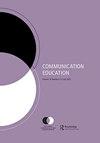Study X of the basic communication course at two- and four-year U.S. colleges and universities: revisiting trends and considering new challenges
IF 0.8
Q3 COMMUNICATION
引用次数: 2
Abstract
ABSTRACT Continuing a tradition dating back to 1968, this tenth study in a longitudinal series of surveys of the basic communication course has two goals: (a) to provide descriptive information about the basic course contemporarily and over time and (b) to propose a framework for interpreting the impact of the extraordinary national and international events of 2020, on higher education in general and the basic communication course in particular. A survey, which retained questions about trends identified in the past nine studies conducted on the basic communication course from 1956 to 2016, was updated to include additional questions on topics of contemporary concern. National distribution of the survey instrument resulted in a total of 160 respondents (26 from two-year schools, 134 from four-year schools). This study reports and discusses data across six categories: (a) general description of the course and enrollment patterns; (b) course instruction, training, and administration problems; (c) standardization and grading; (d) course content and pedagogy; (e) media, technology, and online teaching; and (f) contemporary challenges and issues facing the basic course. Reflections based on trends in the data, and recommendations for future scholarship about the course based on the results and current challenges in higher education, are offered.美国两年制和四年制大学基础沟通课程研究X:重新审视趋势并考虑新的挑战
摘要延续了1968年的传统,这项对基础传播课程进行纵向系列调查的第十项研究有两个目标:(a)提供关于基础课程的当代和长期描述性信息;(b)提出一个框架来解释2020年非同寻常的国家和国际事件的影响,关于一般高等教育,特别是基础传播课程。一项调查保留了1956年至2016年对基础传播课程进行的过去九项研究中发现的趋势问题,并进行了更新,包括了关于当代关注主题的其他问题。调查工具在全国范围内的分布共有160名受访者(26名来自两年制学校,134名来自四年制学校)。这项研究报告并讨论了六类数据:(a)课程和招生模式的一般描述;(b) 课程指导、培训和管理问题;(c) 标准化和分级;(d) 课程内容与教学法;(e) 媒体、技术和在线教学;以及(f)基础课程面临的当代挑战和问题。提供了基于数据趋势的思考,以及基于结果和当前高等教育挑战的未来奖学金建议。
本文章由计算机程序翻译,如有差异,请以英文原文为准。
求助全文
约1分钟内获得全文
求助全文
来源期刊

COMMUNICATION EDUCATION
EDUCATION & EDUCATIONAL RESEARCH-
CiteScore
3.10
自引率
34.80%
发文量
47
期刊介绍:
Communication Education is a peer-reviewed publication of the National Communication Association. Communication Education publishes original scholarship that advances understanding of the role of communication in the teaching and learning process in diverse spaces, structures, and interactions, within and outside of academia. Communication Education welcomes scholarship from diverse perspectives and methodologies, including quantitative, qualitative, and critical/textual approaches. All submissions must be methodologically rigorous and theoretically grounded and geared toward advancing knowledge production in communication, teaching, and learning. Scholarship in Communication Education addresses the intersections of communication, teaching, and learning related to topics and contexts that include but are not limited to: • student/teacher relationships • student/teacher characteristics • student/teacher identity construction • student learning outcomes • student engagement • diversity, inclusion, and difference • social justice • instructional technology/social media • the basic communication course • service learning • communication across the curriculum • communication instruction in business and the professions • communication instruction in civic arenas In addition to articles, the journal will publish occasional scholarly exchanges on topics related to communication, teaching, and learning, such as: • Analytic review articles: agenda-setting pieces including examinations of key questions about the field • Forum essays: themed pieces for dialogue or debate on current communication, teaching, and learning issues
 求助内容:
求助内容: 应助结果提醒方式:
应助结果提醒方式:


